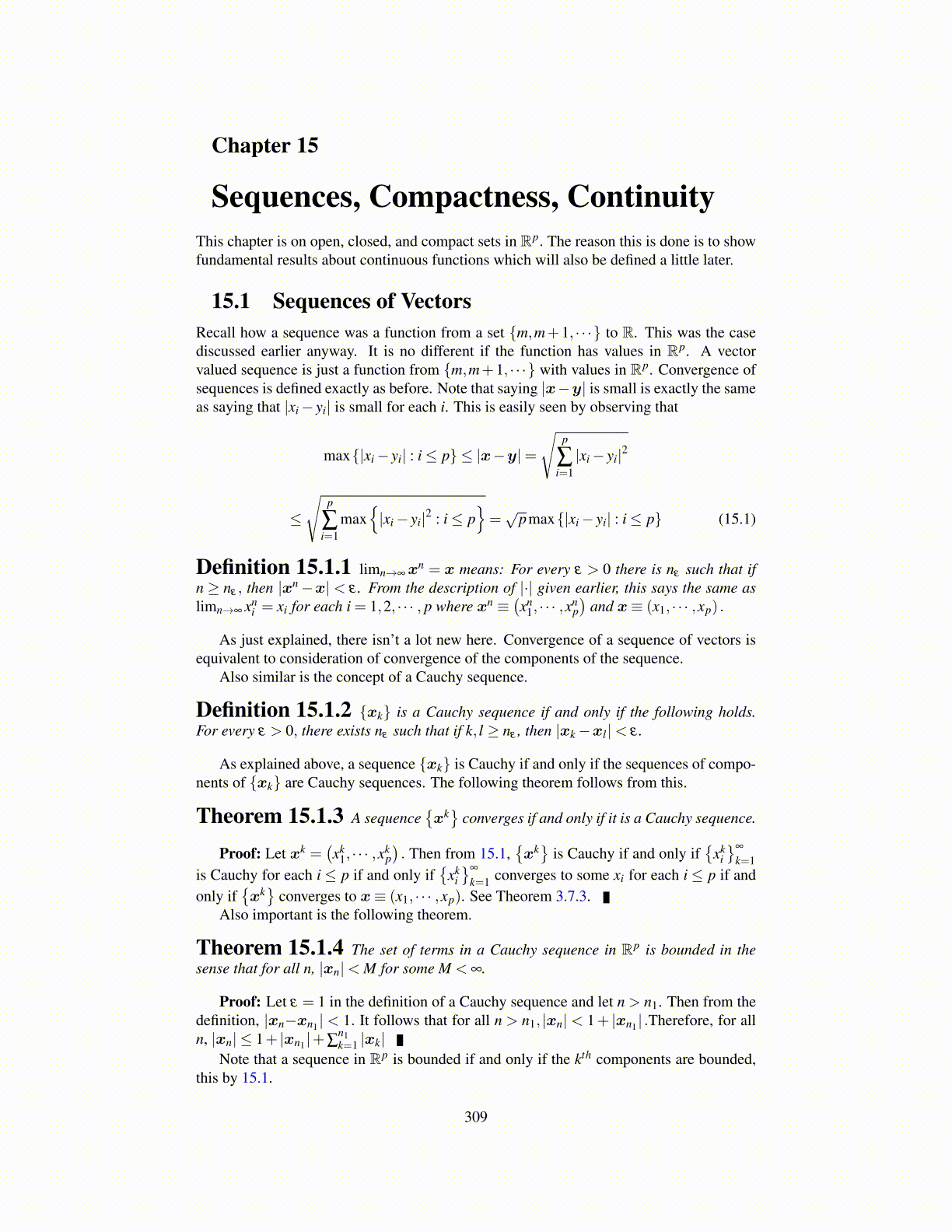
Chapter 15
Sequences, Compactness, ContinuityThis chapter is on open, closed, and compact sets in Rp. The reason this is done is to showfundamental results about continuous functions which will also be defined a little later.
15.1 Sequences of VectorsRecall how a sequence was a function from a set {m,m+1, · · ·} to R. This was the casediscussed earlier anyway. It is no different if the function has values in Rp. A vectorvalued sequence is just a function from {m,m+1, · · ·} with values in Rp. Convergence ofsequences is defined exactly as before. Note that saying |x−y| is small is exactly the sameas saying that |xi − yi| is small for each i. This is easily seen by observing that
max{|xi − yi| : i ≤ p} ≤ |x−y|=
√p
∑i=1
|xi − yi|2
≤
√p
∑i=1
max{|xi − yi|2 : i ≤ p
}=√
pmax{|xi − yi| : i ≤ p} (15.1)
Definition 15.1.1 limn→∞xn = x means: For every ε > 0 there is nε such that ifn ≥ nε , then |xn −x| < ε . From the description of |·| given earlier, this says the same aslimn→∞ xn
i = xi for each i = 1,2, · · · , p where xn ≡(xn
1, · · · ,xnp)
and x≡ (x1, · · · ,xp) .
As just explained, there isn’t a lot new here. Convergence of a sequence of vectors isequivalent to consideration of convergence of the components of the sequence.
Also similar is the concept of a Cauchy sequence.
Definition 15.1.2 {xk} is a Cauchy sequence if and only if the following holds.For every ε > 0, there exists nε such that if k, l ≥ nε , then |xk −xl |< ε .
As explained above, a sequence {xk} is Cauchy if and only if the sequences of compo-nents of {xk} are Cauchy sequences. The following theorem follows from this.
Theorem 15.1.3 A sequence{xk}
converges if and only if it is a Cauchy sequence.
Proof: Let xk =(xk
1, · · · ,xkp). Then from 15.1,
{xk}
is Cauchy if and only if{
xki}∞
k=1is Cauchy for each i ≤ p if and only if
{xk
i}∞
k=1 converges to some xi for each i ≤ p if andonly if
{xk}
converges to x≡ (x1, · · · ,xp). See Theorem 3.7.3.Also important is the following theorem.
Theorem 15.1.4 The set of terms in a Cauchy sequence in Rp is bounded in thesense that for all n, |xn|< M for some M < ∞.
Proof: Let ε = 1 in the definition of a Cauchy sequence and let n > n1. Then from thedefinition, |xn−xn1 | < 1. It follows that for all n > n1, |xn| < 1+ |xn1 | .Therefore, for alln, |xn| ≤ 1+ |xn1 |+∑
n1k=1 |xk|
Note that a sequence in Rp is bounded if and only if the kth components are bounded,this by 15.1.
309